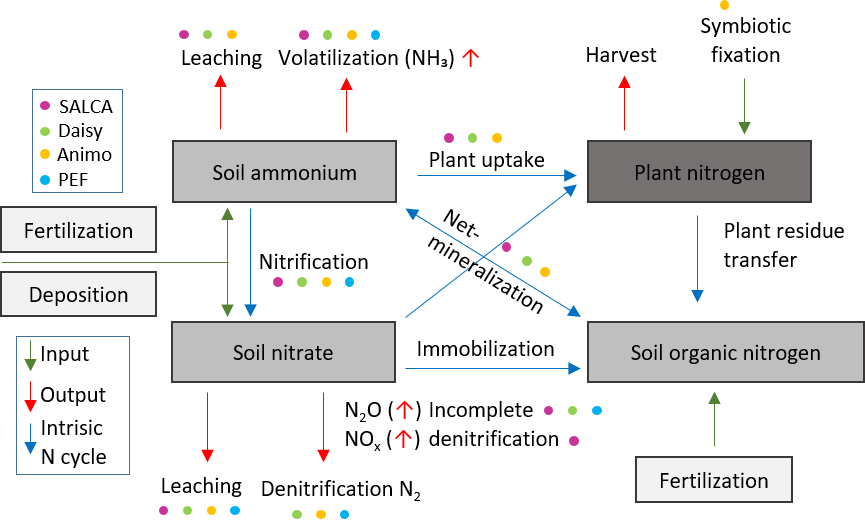08/03/2021
Researchers determine the most suitable model to estimate agricultural emissions
Researchers from URV, IRTA and UPC present a study that faces the challenge of agriculture to minimize the impact on the environment and analyses the models used to estimate nitrogen emissions. The results can be useful for Life Cycle Assessment practitioners

Researchers from URV, IRTA and UPC present a study that faces the challenge of agriculture to minimize the impact on the environment and analyses the models used to estimate nitrogen emissions. The results can be useful for Life Cycle Assessment practitioners
Sustainable agriculture is a real challenge in order to provide enough food for the people, now and for the next generations, and avoiding an excess of impacts on the environment that can also be harmful to the world. In order to assess and quantify environmental impacts, the Life Cycle Assessment (LCA) is a well-spread methodology used in agriculture and other several fields of study. LCA calculates impacts, counting inputs into the system (e.g. raw material, water, energy, and other resources) and outputs (e.g. gas emissions, effluents to water and final product) out of the system, through different models and methods, and taking into account the whole cycle of the product, until its final disposal.
One of the biggest concerns regarding agriculture is the use of fertilizers, especially related to the nitrogen emissions to the air, water and soil. Nitrogen is essential, as fertilizer, for agriculture. However, when not well managed, can contribute to several environmental issues as climate change, eutrophication, acidification, decreasing quality of air, water and soil. Nitrogen emissions can also affect people’s health and well-being.
Thus, it is essential to know as much precise as we can how much of emissions come from the use of fertilizers to proper manage its use. For that calculation, several methods and models are available, some of them being necessary to apply more effort to collect data and others being easily applied. Nowadays, there is not standardized and recommended methods to conduct these estimations.
Knowing that, the research team composed by Edilene Pereira, August Bonmatí, Erica Montemayor, Assumpció Antón and Laureano Jimenez (from IRTA, URV and UPC) has compared four different models, since the simplest until two complex which require a lot of information. The performance of the models was evaluated according to their potential feasibility to be used in estimating emissions in LCA. For that, they created an adapted version of the criteria proposed by the United Nations Framework Convention on Climate Change (UNFCCC), and other relevant studies, to judge their suitability in LCA was used. They intended to show the differences between the limitations of each one and, more important, the potential differences in the final LCAs when using one model or the other. In addition, the criteria selected to compare them, can be useful for LCA practitioners or another expert who wants to know more the models looking at key points in the models.
The models scored very closely in total, but differently in the criteria selected. Therefore, it is important to take into account that the models were created to be used under some circumstances and conditions, and those should be respected in order to obtain adequate and reliable results. Amount of data is the main obstacle to use robust models, but they can provide more realistic emissions. Thus, the perfect model for LCA would be a model that has a vast library, requiring few input data, but, at the same time, that be site and time-specific. Another important outcome of their research was that LCA urgently need a solid methodology to estimate nitrogen emissions, but robust models as the ones used in this work could be used to estimate default values, that would facilitate the calculation of the emissions for different archetype scenarios.

This research, recently published in the International Journal of Life Cycle Assessment, is part of the project Nutri2Cycle, funded by the European Union’s Horizon 2020 research and innovation programme (773682). The doctoral thesis of Edilene Pereira is in line with this project. She is one of the 45 doctoral researchers contracted through the URV’s Martí i Franquès COFUND Programme in its second edition. Her research has also received funding from the H2020 program under the Marie Skłodowska-Curie Actions (713679), by the URV, by Banco Santander and by IRTA.
Reference: Edilene Pereira Andrade, August Bonmatí, Laureano Jiménez Esteller, Erica Montemayor & Assumpció Antón Vallejo. Performance and environmental accounting of nutrient cycling models to estimate nitrogen emissions in agriculture and their sensitivity in life cycle assessment. International Journal of Life Cycle Assessment (2021). https://doi.org/10.1007/s11367-021-01867-4
